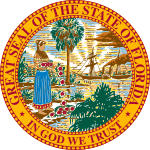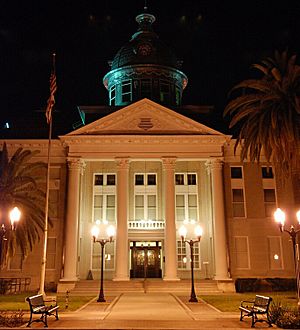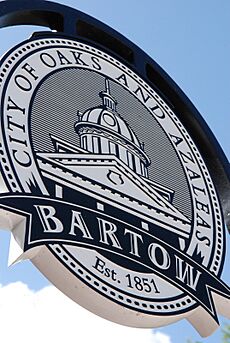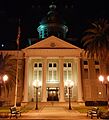History of Bartow, Florida facts for kids
Quick facts for kids History of Florida |
|
|---|---|

The seal of Florida reflects the state's Native American ancestry
|
|
| Historical Periods | |
| Pre-history | until 1497 |
| Spanish Rule | 1513–1763 |
| British Rule | 1763–1783 |
| Spanish Rule | 1783–1821 |
| U.S. Territorial Period | 1822–1845 |
| Statehood | 1845–present |
| Major Events | |
| American Revolutionary War | 1775–1783 |
| War of 1812 | 1811–1814 |
| First Seminole War | 1817–1818 |
| Capitol moved to Tallahassee |
1824 |
| Second Seminole War | 1835–1842 |
| Constitutional convention | 1838 |
| Third Seminole War | 1855–1858 |
| Ordinance of Secession | 1861 |
| Civil War | 1861–1865 |
| 3rd Constitution | 1865 |
| Reconstruction | 1865–1868 |
| 4th Constitution | 1868 |
| 5th Constitution | 1885 |
| Great Migration | 1910–1930 |
| Land Boom | 1925–1929 |
| 6th Constitution | 1968 |
| Gore v. Harris 2000 Presidential Election |
2000 |
| Timeline | |
The history of Bartow, Florida goes back over 150 years. But people have lived in this area for nearly 12,000 years! Redding Blount started the city in 1851. It began as a small outpost on the frontier. It was a place where settlers might face attacks from Seminole Indians. Today, Bartow is the county seat of Polk County. This county is now home to more than half a million people.
Bartow is located in the middle of Florida. It's also near the center of Polk County. This means Bartow has often been part of big changes in Florida. Even so, the city has tried to stay much the same. Bartow is at the start of the Peace River. It's less than an hour from busy cities like Tampa and Orlando. Yet, Bartow has stayed a small city. This is true even with fast growth all around it.
It's interesting that Bartow might grow a lot now. This is happening as growth in the rest of Florida is slowing down. Bartow has added over 18,000 acres of land. This land used to be for phosphate mining. It was owned by the Clear Creek Development Company. Now, Bartow is more than four times its original size. Its population is expected to triple in the next twenty years.
People in Bartow sometimes say that no other town has produced more famous people. This is based on its size, like Jamestown. It's a fun idea to think about! But there's no doubt Bartow has had many important people. They have achieved great things in many ways. For example, Spessard Holland was a Florida governor and U.S. senator. Katherine Harris was a Florida Secretary of State. Karen Olivo is an actress who won a Tony Award. Rick Wilson was a stock car driver. Ray Lewis was a Pro Bowl linebacker. Bubba Stewart is a motocross legend. Three United States generals also came from here. These people were born, raised, or connected to the City of Oaks and Azaleas.
Contents
Early Florida: From Ice Age to Statehood
The land of Florida has changed a lot over time. Sometimes it was a group of small islands. Only high places, like ridges in Polk County, were above water. Other times, Florida was much wider than it is today. The first people, called Paleo-Indians, probably came to the Bartow area when Florida was widest. They followed large animals like woolly mammoths south. The weather back then was cooler and drier. It was likely similar to the weather in the British Isles today.
These first people arrived near the end of the last ice age. They were hunters and gatherers. They didn't leave many signs of their lives. As the ice melted, sea levels rose. New groups of Native Americans then settled permanently. These groups lived well in Florida for thousands of years. By the time the first Spanish explorers arrived, about 250,000 Native Americans lived here. Some early tribes were the Tocobago, Timucua, and Calusa.
In 1527, a Spanish map showed a settlement near the Rio de la Paz. But the arrival of the Spanish was very bad for these tribes. Within 150 years, most Native Americans in Florida were gone. Many died from diseases like Small Pox. Others were killed or enslaved. Not much is left of these early cultures in Polk County. We only have a few old tools and shell mounds. Later, the remaining people from these tribes joined with Creek Indians. These Creek Indians came from the north. Together, they formed the Seminole Indian tribe.
Meanwhile, European countries fought for control of Florida. Spain, France, and Great Britain all took turns controlling Florida. Finally, the United States gained control in 1819. By this time, the Seminoles had settled in Florida. They made it hard for white settlers to move in. The United States first tried to make the Seminoles live on a large reservation. This area covered much of Central Florida, including today's Bartow. After the First Seminole War, the U.S. passed the Indian Removal Act of 1830. This law tried to move most Seminoles to Oklahoma.
Bartow's Beginnings Before the Civil War
In 1845, Florida became the 27th state. It seemed like a good time for the southern part of Florida to grow. But this growth was slow at first. The heat, humidity, dangerous wildlife, and swamps made life hard. A bigger worry was the Seminoles who chose to stay. Most of these Indians were peaceful. But many white settlers felt uneasy. They heard stories of attacks "not far away." So, many early settlements were built like forts. This was to discourage any Indian attacks.
The Armed Occupation Act of 1842 said people could not settle near the Peace River. This was considered Seminole land. However, cattlemen from Tampa Bay moved into the Peace River area anyway.
In 1851, Redding Blount started a settlement called Fort Blount. It was just west of where downtown Bartow is now. This settlement was later called Peace Creek or Peas Creek. As more people settled, they started planting citrus trees. They also built one-room schoolhouses and churches.
The Civil War Years
About a month after Florida left the Union, Polk County was formed. It was made from the eastern part of Hillsborough County. A small piece of Brevard County was also added. Records show there were three voting areas then. These were Ft. Meade, Fort Fraser (near Highland City), and Socrum (north of Lakeland). The first place chosen for the county seat was near Highland City. But the war delayed plans to build it.
At that time, few families lived in Polk County. The Civil War was very hard on daily life here. Trade and schooling almost stopped by the end of the war. When the war ended, only one school was open in the whole county. It was in Bartow. Fort Meade, the largest city then, was burned down in May 1864.
After the War: Reconstruction and Growth
After the war, the county leaders decided to rename the town Bartow. They named it after the first Confederate officer who died in the war. Around this time, a rich cattleman named Jacob Summerlin gave a large piece of land. This land was part of the old Blount homestead. It was used to build the first Polk County courthouse. It also became the site of the first high school in the county and two churches. This was a very important event for Bartow and Polk County.
Growth was slow at first. By 1880, Bartow had fewer than 400 permanent residents. But the town grew very fast in the late 1800s. In 1887, the first brick schoolhouse south of Jacksonville was built. This school was called Summerlin Institute. It is now Bartow High School. It became one of the most respected high schools in the Southern United States. Around the same time, the first library in central Florida was built. By 1900, Bartow was the third most populated city in central Florida. It was the fifteenth most populated in the state.
Bartow in the 20th Century and Today
During the 1900s, Bartow grew slowly. This was different from the rest of Florida, which had a huge population boom. In 1909, a new courthouse was built. It was on the corner of Main Street and Broadway Avenue. This courthouse is still standing. It is now the Polk County Historical Museum.
As the city grew, different industries came to the Bartow area. In the early 1900s, thousands of acres around the city were bought. These were bought by the phosphate industry. Bartow became the center of the largest phosphate industry in the United States. After several freezes north of Polk County, the county became the top citrus county in the U.S. Much of the farming around Bartow is still based on citrus.
In 1941, the city built an airport. It was northeast of town. The federal government took over this airport during World War II. Many Army Air Corps pilots trained there. The airport was given back to the city in 1967.
In 2004, Bartow was hit hard by three hurricanes. They all hit within 44 days. The center of all three hurricanes passed very close to town. These were Hurricane Charley, Hurricane Frances, and Hurricane Jeanne. The damage from the storms, especially Charley, was huge. Every school in the county was damaged. Schools were closed for two weeks. For many months after, blue tarps on rooftops were a common sight.
For most of the 20th century, Bartow's growth was small. This was especially true compared to the rest of the county and state. Other cities in Polk County grew fast. They added nearby land. But Bartow's government was more careful. This has changed in the last ten years. A financier named Stanford Phelps bought the old Clear Springs phosphate land. When the Clear Springs development is finished by 2030, Bartow's population could almost triple. It might reach over 45,000 residents.
African American History in Bartow
In 2000, about 28% of Bartow's population was African American. Bartow has a history that shows what life was like in the Deep South. The experiences of white and black people in Bartow have been different over the years. Important figures like Francis Bartow, Jacob Summerlin, and Spessard Holland were white. Their stories are often told in history books. But sometimes, the history of black people in Bartow is not as well known.
An interesting fact is that the first non-Indian settlers in the Bartow area were not from Fort Blount. In 1818, a small group of escaped slaves from other states moved here. They started a settlement called Minatti. This was thirty years before the first white settlers arrived. The people of Minatti were sometimes called Black Seminoles. This was because they shared some Seminole culture or had married into the tribe.
Later, white settlers came and brought enslaved people to Peas Creek. The area where African American enslaved people lived was on the west side of town. White people called it "the Negro Quarters" or "The Quarters." Black people called it "Over the Branch." This area was separated from the rest of Bartow by a small creek called McKinney Branch.
Images for kids





